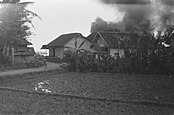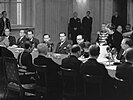
Indonesian National Revolution
1945–49 Indonesian conflict and diplomatic struggle against Dutch rule / From Wikipedia, the free encyclopedia
Dear Wikiwand AI, let's keep it short by simply answering these key questions:
Can you list the top facts and stats about Indonesian National Revolution?
Summarize this article for a 10 year old
The Indonesian National Revolution (Indonesian: Revolusi Nasional Indonesia), also known as the Indonesian War of Independence (Dutch: Indonesische Onafhankelijkheidsoorlog), was an armed conflict and diplomatic struggle between the Republic of Indonesia and the Dutch Empire and an internal social revolution during postwar and postcolonial Indonesia. It took place between Indonesia's declaration of independence in 1945 and the Netherlands' transfer of sovereignty over the Dutch East Indies to the Republic of the United States of Indonesia at the end of 1949.[21]
| Indonesian National Revolution | |||||||||
|---|---|---|---|---|---|---|---|---|---|
| Part of the aftermath of World War II and the decolonisation of Asia | |||||||||
From top, left to right:
| |||||||||
| |||||||||
| Belligerents | |||||||||
|
Internal conflict: |
| ||||||||
| Commanders and leaders | |||||||||
|
|
| ||||||||
| Strength | |||||||||
| Casualties and losses | |||||||||
|
• Netherlands: 4,585 killed[12][lower-alpha 5]
• United Kingdom: 980 killed[13] • Japan: 1,293 killed[lower-alpha 6] • 5,500–20,000 Indo people and European civilians killed and 2,500 missing[17][18][19][20] | |||||||||
The four-year struggle involved sporadic but bloody armed conflict, internal Indonesian political and communal upheavals, and two major international diplomatic interventions. Dutch military forces (and, for a while, the forces of the World War II allies) were able to control the major towns, cities and industrial assets in Republican heartlands on Java and Sumatra but could not control the countryside. By 1949, international pressure on the Netherlands, the United States threatening to cut off all economic aid for World War II rebuilding efforts to the Netherlands and the partial military stalemate became such that the Netherlands transferred sovereignty over the Dutch East Indies to the Republic of the United States of Indonesia.[22]
The revolution marked the end of the colonial administration of the Dutch East Indies, except for New Guinea. It also significantly changed ethnic castes as well as reducing the power of many of the local rulers (raja). It did not significantly improve the economic or political fortunes of the majority of the population, although a few Indonesians were able to gain a larger role in commerce.[23]





